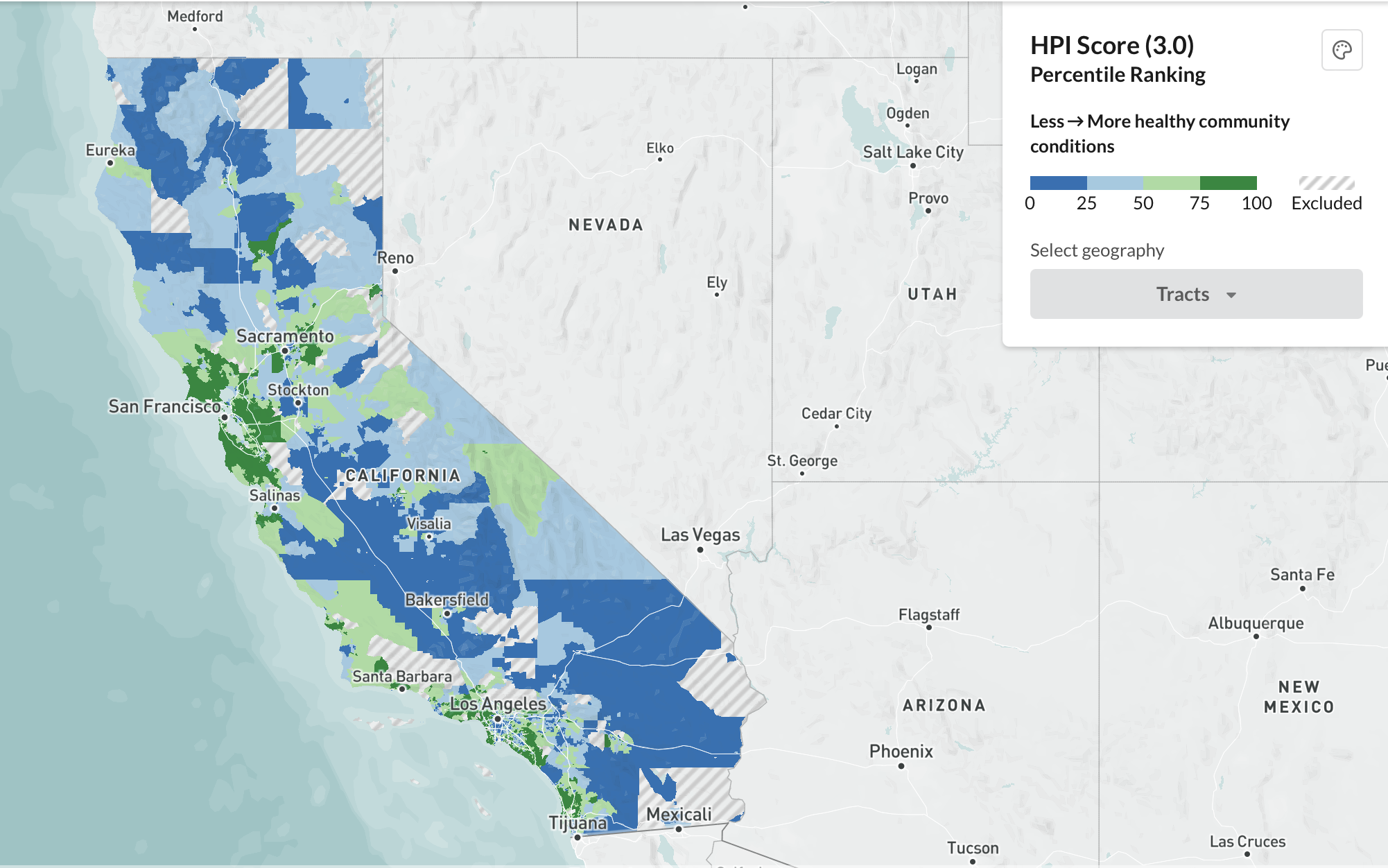
Late afternoon aerial view of the Laguna Beach, California coastline. (Photo: Matt Gush, Shutterstock)
How Healthy is the Healthy Places Index?
A part of the occasional ‘Hidden in Plain Site’ series
By Thomas Buckley, December 10, 2023 10:18 am
It would be understandable to think that something called the Healthy Places Index would use the actual health of a place to create a ranked index.
But that turns out to not quite be true, as the HPI® – a standard cobbled together by the Public Health Alliance of Southern California and used statewide to help funnel massive amounts of government money hither and yon – uses multiple factors to decide what places are healthy and only one (maybe two) of them is directly related to health.
The HPI® uses eight weighted factors to come up with its overall index ranking – only one, how many people have health insurance in a given area, can be said to be directly “heath” related. A second rating “domain” that could reasonably be said to impact health is the “clean environment” rating element.
But between the two they make up only 10.5% of the weighted factors, meaning having health insurance and having cleaner air is considered by the HPI® to be less a factor in overall community health than:
- Economic issues – 35%
- Education – 18%
- Transportation – 13%
- Social – 13%
- Housing – 5.3% (the same as health insurance)
- Neighborhood – 5.2% (the same as clean environment)
As shown in the table below, each of the domains contains sub-factors. Economic issues involves income and unemployment, education involves the number of people with college degrees and number of people in school, transportation involves people who have cars and how many people use other ways to get around, neighborhood is based on access to parks and shopping and shade (more on that later,) housing involves home ownership and in what shape and how crowded those homes are, and clean environment involves smog and diesel exhaust prevalence.

Note: For an even more detailed look at the factors, here is a PDF of the “technical report” – the specific breakout is on pages 35-36 of the file, 28-29 of the report itself.
“Social” is one of the more interesting – and troubling – ratings as it is based on how many people vote and/or responded to the census.
The idea that voting is more indicative of a healthier community than having health insurance seems counter-intuitive until one realizes that much of the public health field has morphed its mission lately to include everything under the “health and safety” rubric.
As a spokesperson for The California Foundation – a multi-billion dollar non-profit that was meant to increase health insurance coverage but in fact spends the vast majority of its funds on salaries and giving money to community “activist” groups who do things like operate dodgy, biased “get out the vote” efforts – put it:
“(It’s) not just health care, it is shown through research and other health experts that the place where you live, work, go to school, play, etc. can have both negative and positive impact on your health” and that “patient advocacy for better access and improved health care is important and is not a political activity.”
The HPI® specifically follows this concept. From its latest technical report:
The HPI® utilizes the following definition of health disadvantage: Health disadvantage is the inability of people to fulfill basic human needs required for full social participation and optimal health and well-being. These needs include but are not limited to the needs for economic security, food, shelter, safety, transportation, education, social connection and political participation.
The definition incorporates a holistic concept of health and recognition that health is produced by community factors not addressed by our health care system. As articulated by the World Health Organization, health is “a state of complete physical, mental and social well-being and not merely the absence of disease or infirmity” and the fundamental resources for health are “… peace, shelter, education, food, income, a stable ecosystem, sustainable resources, social justice, and equity.”
By making the definition of health care broad to the point of meaninglessness, groups like the Endowment and projects like the HPI® can claim anything they wish as being health-related, opening up avenues to power and funding that would not be available otherwise.
The deep notes about the HPI® do say, for the lack of a better term, it tries to correlate with the community’s life expectancy at birth (LEB) number, but it intentionally excludes other health information so as not to skew the numbers.
“…(L)ife expectancy at birth as the health outcome for the development of domain weights and validation because of its broad recognition as a key indicator of community health status. We included no health outcomes in the HPI® itself to avoid autocorrelation with life expectancy at birth,” states the “California Healthy Places Index: Frames Matter” paper on the process.
Another interesting aspect of the HPI® is its tenuous relationship to race and ethnicity. Since – because of Proposition 209 – state funding cannot be directly allocated based on race, the HPI® has a separate “domain” on race that can be layered over the “regular” map that has been produced: https://map.healthyplacesindex.org/?redirect=false

Also interestingly, but unsurprisingly, the HPI® correlates extremely closely to how well off a community is; in other words, the HPI® clearly implies that rich = healthy, something that anyone who has ever spent any time in a country club bar may not exactly be the case.
All of this may seem rather esoteric bureaucrat gobbledygook, but the HPI® has very real world implications.
“The wealth of data that HPI® puts at people’s fingertips is extraordinary. From its well-researched asset-based frame of conditions that shape our health, to its depth of detail with granular data, to its accessibility of policy solutions, the Index should be the first stop for everyone working to improve health in California,” said Public Health Institute President & CEO Mary A. Pittman.
Amongst other things, the internationally-recognized PHI “leads and manages public health projects as a fiscal sponsor. This means that we provide operational infrastructure and guidance to public health programs all over the world to accelerate their work and maximize their impact.”
In other words, they actively play in the public health money and policy pool.
As does the HPI®, which claims it has been used to help direct more than $4.5 billion dollars in funding since its inception in 2018.
“Now in its third release, the HPI® has become a go-to data tool for hundreds of state and local government agencies, foundations, advocacy groups, hospitals and other organizations that want to apply a health equity lens to their work,” the website states.
Amongst its organizational policies are such items as the problems of “sea level rise,” improving public transit, adequate shade, and extreme heat.
And it is in the context of this last item – heat – that the public was most recently exposed to the sway of the HPI®, with multiple media outlets across the state reporting that the HPI® shows extreme heat is bad which the Los Angeles Times covered in gushingly slavish terms.
The HPI® even came out with a special “extreme heat” edition, as it were, in which it modeled – and we all know how accurate most scientific models are – future weather to show how incredibly hot its going to get pretty much everywhere in the state, except along the coast.
This, say advocates, is yet another reason the coastal counties need to build more housing and become even more densely populated.
So from zoning to voting, the HPI® is a non-health based health rating that activists, government agencies, and foundations to use to shape the lives of Californians as they wish
That doesn’t seem like a healthy place at all.
Broken Record Note – the Public Health Alliance of Southern California did not respond to requests for comments, explanations, etc. And yes, since the HPI® obsessively uses the “®” we did as well.





Lists like this are always compiled with an agenda in mind and it is never the stated purpose. Leftists publish such studies and their priorities are pretty much always leftist agenda points rather than anything germane to the actual stated purpose.
Long gone are the days when government or even private groups are even remotely concerned with the actual well being of Americans.
Bottom line is anything put out by the Public Health Alliance of Southern California is pure propaganda! Just another organization that exists purely to push the democratic party and communism / fascism, smear anyone that gets in their way and take as much money and power as possible!